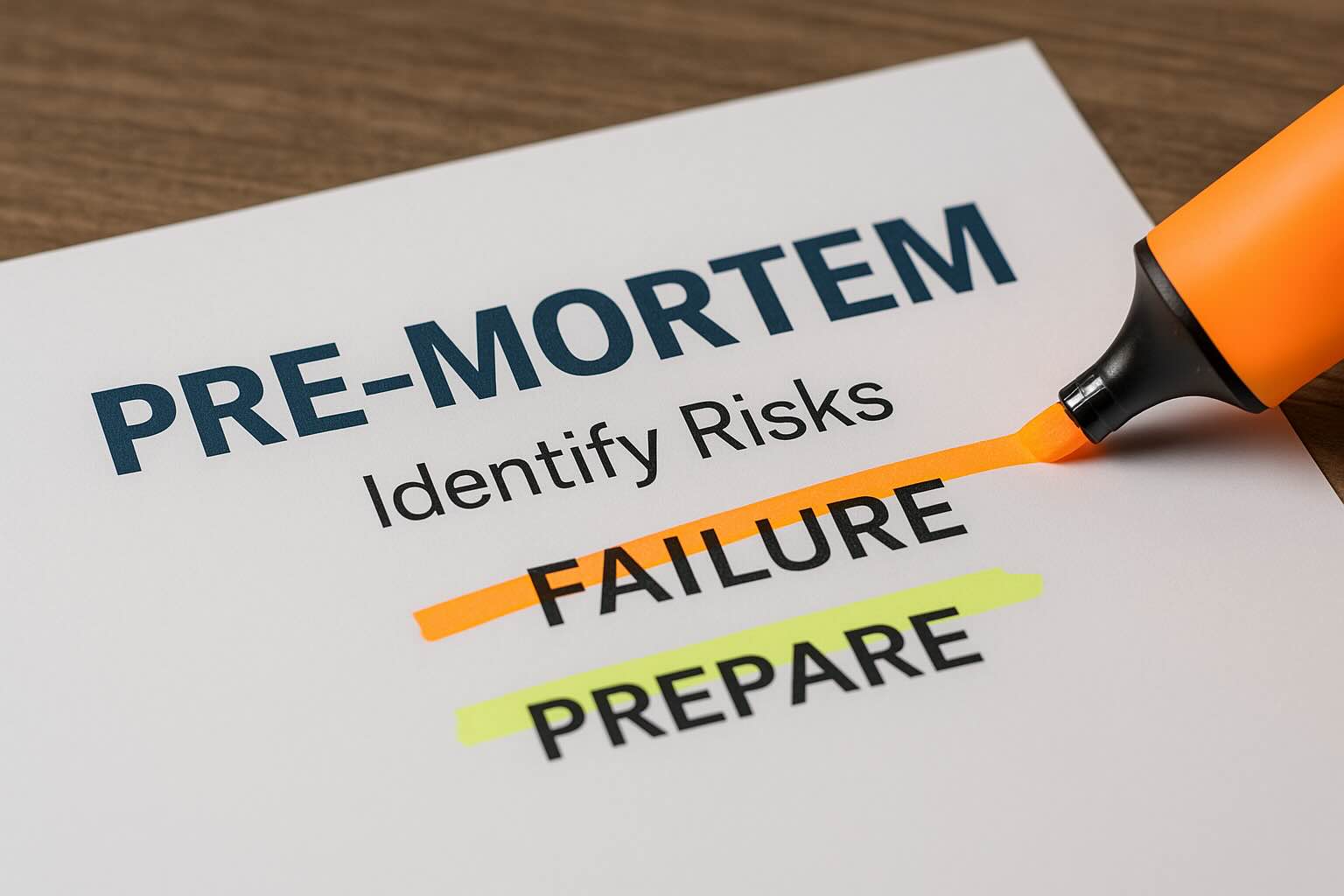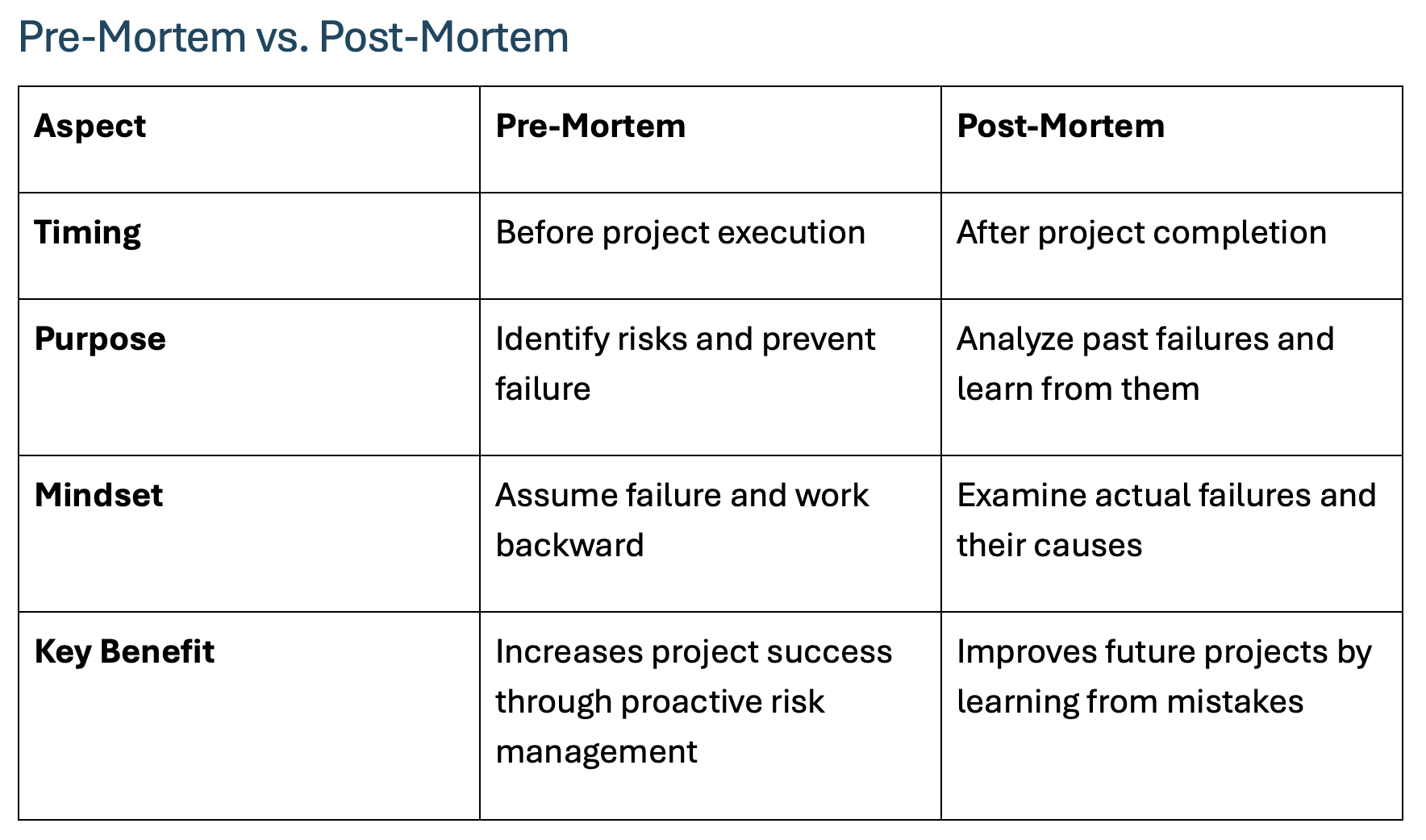TCI Pre-Mortem Guide

A Structured Framework for Risk Identification and Failure Prevention
Overview
The Pre-Mortem technique is a structured, proactive approach to risk assessment and failure prevention. Developed by cognitive psychologist Gary Klein, it helps teams anticipate potential project failures before they happen. Unlike traditional risk assessments, which assume success and identify potential obstacles, the Pre-Mortem assumes failure has already occurred and then works backward to determine why.
This guide follows the TCI structured approach, ensuring aclear, collaborative, and actionable process for teams looking to improvedecision-making and mitigate risks before execution.
Why Use a Pre-Mortem?
The Pre-Mortem helps teams:
- Identify risks early – Reduces the likelihood of unexpected failures by addressing potential issues before they arise.
- Foster psychological safety –Encourages team members to voice concerns in a structured way without fear of being overly negative.
- Improve project success rates – Helps refine strategies, align stakeholders, and create contingency plans before execution.
- Strengthen decision-making – Forcesteams to think critically about weak points, increasing accountability and preparedness.
- Reduce costly mistakes – Proactive identification of risks leads to smarter planning and resource allocation.

Notable Uses of Pre-Mortem Analysis
Google’s Moonshot Projects
GoogleX (now X, The Moonshot Factory - and yes, in July 2025 it is actually called X) uses Pre-Mortems to identify reasons why ambitious projects might fail before they invest significant resources.
Amazon’s ‘Future Press Release’ Approach
Teams write mock press releases explaining why a project failed, encouraging proactive risk identification.
NASA’s Risk Management Strategy
NASA has used variations of Pre-Mortems in mission planning to anticipate failure scenarios and improve safety protocols.
Healthcare & Hospitals
Hospitals conduct Pre-Mortems before surgeries and new patient safety initiatives to prevent medical errors.
Startups & Venture Capital Firms
VCs and founders use Pre-Mortems before launching products or securing investments to reduce the risk of market failure.
How to Conduct a Pre-Mortem
Step 1: Set the Stage (5-10 minutes)
- The facilitator introduces the purpose: “Imagine it’s six months from now, and this project has completely failed. Let’s figure out why.”
- Ensure participants feel comfortable contributing without judgment.
Step 2: Assume Failure and Identify Causes (15-30 minutes)
- Each participant writes down why they think the project failed.
- Encourage a wide range of perspectives, including technical, operational, market, andhuman factors.
- Example Failure Reasons:
- The product didn’t meet market needs.
- Key talent left midway through the project.
- Budget was underestimated, and we ran out offunds.
Step 3: Identify Early Warning Signs (10-15 minutes)
- For each failure scenario, discuss what warning signs would have indicated the issue early on.
- Example early Warnings:
- Low customer engagement in beta tests.
- Delays in hiring key personnel.
- Budget constraints flagged in earlyfinancial reviews.
Step 4: Develop Risk Mitigation Strategies (15-30 minutes)
- Prioritize key risks and brainstorm ways to prevent them.
- Assign owners to specific risk-mitigation actions.
- Example Solutions:
- Conduct early customer validation before development.
- Create redundancy in key roles to avoid knowledge gaps.
- Secure contingency budget for unexpected overruns.
Step 5: Document and Act (5-10 minutes)
- Summarize the key risks, warning signs, and action items in a simple format.
- Assign responsibilities and set follow-up dates for risk monitoring.
Conclusion: Why Every Team Should Use a Pre-Mortem
By simulating failure before execution, teams can proactively mitigate risks, improve strategic planning, and increase their chances of success. This method is particularly effective for high-stakes projects, new initiatives, and complexdecision-making scenarios.
Key Benefits:
✔ Prevents avoidable failures by surfacing risks early.
✔ Encourages open discussions in a psychologically safe environment.
✔ Improves accountability by assigning risk mitigation responsibilities.
✔ Enhances decision-making through structured, forward-thinking analysis.
Prevention is always more effective than damage control. Implementing Pre-Mortems in your decision-making process ensures you anticipate and neutralize risks before they become costly mistakes.





.svg)
.png)
.svg)


.svg)